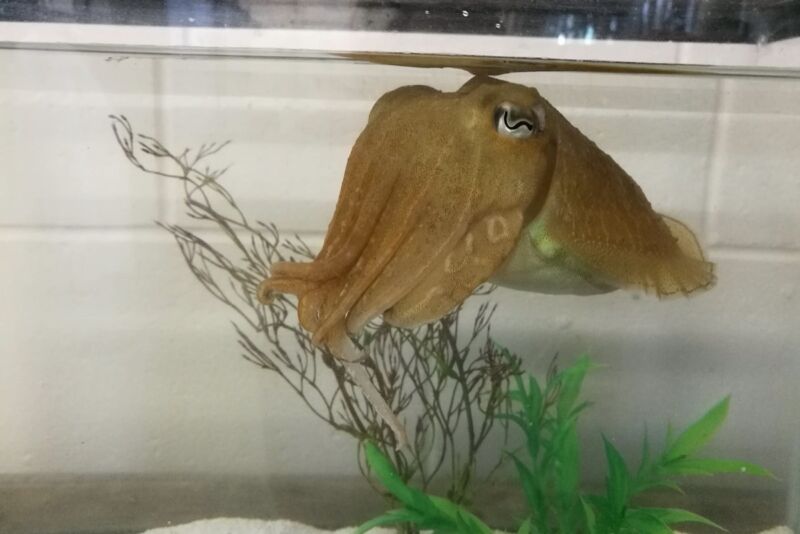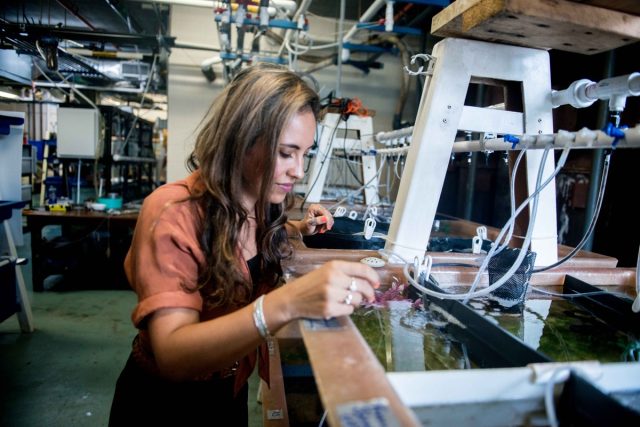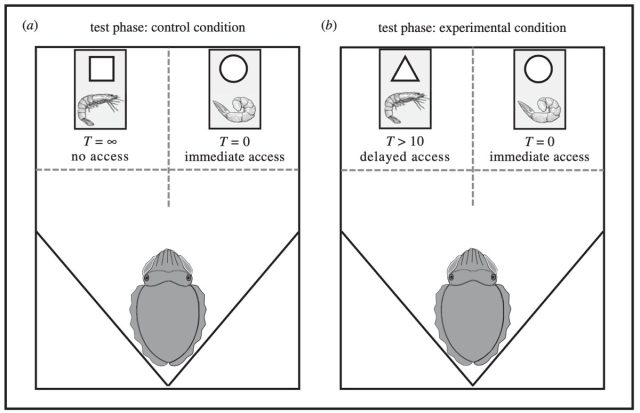
Certain species show a remarkable ability to delay gratification, notably great apes, corvids, and parrots, while other species do not (such as rodents, chickens, and pigeons.) Add the cuttlefish to the former category.
Scientists administered an adapted version of the Stanford marshmallow test to cuttlefish and found the cephalopods could delay gratification—that is, wait a bit for preferred prey rather than settling for a less desirable prey. Cuttlefish also performed better in a subsequent learning test, according to a new paper published in the journal Proceedings of the Royal Society B. It's the first time such a link between self-control and intelligence has been found in a non-mammalian species.
As we've previously reported, the late Walter Mischel's landmark behavioral study involved 600 kids between the ages of four and six, all culled from Stanford University's Bing Nursery School. He would give each child a marshmallow and give them the option of eating it immediately if they chose. But if they could wait 15 minutes, they would get a second marshmallow as a reward. Then Mischel would leave the room, and a hidden video camera would tape what happened next.
Some kids just ate the marshmallow right away. Others found a handy distraction: covering their eyes, kicking the desk, or poking at the marshmallow with their fingers. Some smelled it, licked it, or took tiny nibbles around the edges. Roughly one-third of the kids held out long enough to earn a second marshmallow. Several years later, Mischel noticed a strong correlation between the success of some of those kids later in life (better grades, higher self-confidence) and their ability to delay gratification in nursery school. Mischel's follow-up study confirmed the correlation.
Mischel himself cautioned against overinterpreting the results, emphasizing that children who simply can't hold out for that second marshmallow are not necessarily doomed to a life of failure. A more nuanced picture was offered by a 2018 study that replicated the marshmallow test with preschoolers. It found the same correlation between later achievement and the ability to resist temptation in preschool, but that correlation was much less significant after the researchers factored in such aspects as family background, home environment, and so forth. And a 2020 German study adapted the classic experimental setup using Oreos and vanilla cookies with German and Kenyan schoolchildren. That study found that kids are more likely to delay gratification when they depend on each other.
Other select species have also shown the ability to delay gratification through "future-oriented foraging." Apes and corvids, for instance, respond to a variable and unpredictable food supply by not eating some food items immediately to prepare for any future scarcity. University of Cambridge biologist Alexandra Schnell, lead author of this latest study, wanted to explore whether cuttlefish (Sepia officinalis, a relative to the octopus and the squid), could also exhibit self-control, during a fellowship at the Marine Biological Laboratory in Woods Hole, Massachusetts. Past studies had shown that cuttlefish could optimize foraging behavior and could remember details of what, where, and when from past forages, adjusting their strategy in response to changing prey conditions. But was this future-oriented foraging evidence of self-control?
To find out, Schnell and her collaborators first conducted tests to determine preferred prey for the six 9-month-old cuttlefish used in their experiments: live grass shrimp, live Asian shore crab, and pieces of raw king prawn. The cuttlefish turned out to be fairly finicky eaters, showing the least preference for the Asian shore crab; some of the cuttlefish wouldn't eat the crab at all. Between the remaining two types of prey, the cuttlefish showed a marked preference for the live grass shrimp over the raw king prawn.

For the experimental setup, the team 3D-printed a two-chamber apparatus, consisting of two black plastic drawers, each with a transparent sliding door so the cuttlefish could see the contents. Each chamber was given its own detachable, uniquely shaped symbol. The team placed the apparatus in an aquarium and then used PVC barriers at the other end of the tank to keep the cuttlefish an equal distance from both chambers.
Next, the cuttlefish went through a dual training phase. In the first, the cephalopods were placed in the aquarium and then presented with a single chamber marked with one of the visual symbols, to train the subjects to associate that space with a particular degree of accessibility to the prey. For instance, one symbol was associated with immediate accessibility to the prey (instant gratification); another was associated with delayed release, followed by access to the prey (delayed gratification); and a third was associated with inaccessibility to the prey (no gratification). In the third option, the cuttlefish would encounter a clear barrier keeping them from the prey after the sliding door was opened following a short delay.
The second training phase involved single-choice selection. There were two unmarked chambers (no associated symbols) baited with the same type of prey. When the cuttlefish made a "choice" by approaching one of the chambers, the prey in the other chamber was immediately removed. The test subjects also went through a pretest phase to teach them that the lengths of the delays in accessibility to prey would consecutively increase. In this pretest, the delay duration ranged from two seconds to 20 seconds, and each cuttlefish had to "choose" between an immediate and a delayed option.
For the actual experiment, the cuttlefish had to choose between two different prey items: it could choose to eat the raw king prawn immediately, or delay gratification for the preferred live grass shrimp. (A control group of cuttlefish had to choose between immediate access to prey and no access at all.) Subjects could see both options for the duration of the trial and could give up waiting at any point and eat the king prawn if they got tired of holding out for the grass shrimp. The team also subjected the cuttlefish to a learning task to assess cognitive performance. The cephalopods first learned to associate a visual symbol with a specific prey reward, and then the researchers reversed the situation so that the same reward was associated with a different symbol.

The results: "Cuttlefish in the present study were all able to wait for the better reward and tolerated delays for up to 50-130 seconds, which is comparable to what we see in large-brained vertebrates such as chimpanzees, crows, and parrots," said Schnell. Furthermore, "The cuttlefish that were quickest at learning both of the associations [with the food reward] were better at exerting self-control."
Humans may have evolved the ability to delay gratification as a means of strengthening social bonds, thereby benefiting the species as a whole. In apes, corvids, and parrots, the evolutionary driver might be linked to their use of tools and storage of food (caching behavior), as well as strengthening social bonds. But cuttlefish do not use tools or store food, and they are not a social species. Rather, cuttlefish seem to have developed this link between self-control and cognitive performance via a completely different evolutionary pathway—an example of convergent evolution.
"Cuttlefish spend most of their time camouflaging, sitting and waiting, punctuated by brief periods of foraging," said Schnell of her working hypothesis for how the cephalopods may have developed this ability to exert self-control. "They break camouflage when they forage, so they are exposed to every predator in the ocean that wants to eat them. We speculate that delayed gratification may have evolved as a byproduct of this, so the cuttlefish can optimize foraging by waiting to choose better quality food."
DOI: Proceedings of the Royal Society B, 2021. 10.1098/rspb.2020.3161 (About DOIs).
"can" - Google News
March 03, 2021 at 07:06AM
https://ift.tt/3078MSw
Cuttlefish can pass the marshmallow test - Ars Technica
"can" - Google News
https://ift.tt/2NE2i6G
https://ift.tt/3d3vX4n
Bagikan Berita Ini














0 Response to "Cuttlefish can pass the marshmallow test - Ars Technica"
Post a Comment